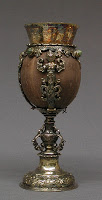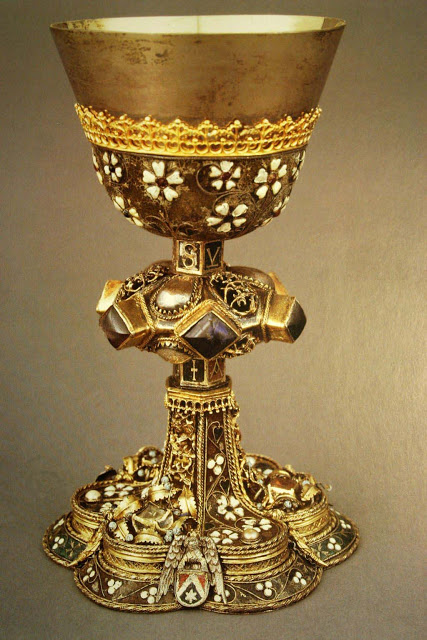Medieval History
One of the most important collection of Hungarian goldsmith works outside Hungary was assembled by financier Nicolas M. Salgó, former US ambassador in Budapest. Salgó collected all kinds of Hungarian art; his painting collection was donated to the Zimmerli Art Museum at Rutgers in 2006, as you can read here.
Most important, however, is his collection of Hungarian silver, which was cataloged by an expert from the Hungarian National Museum, Judit H. Kolba. The handsome English-language catalog was first published in 1996, and is still in print (Hungarian Silver: The Nicolas M. Salgo Collection. London, 1996): see here.
The collection includes two superb medieval chalices from Hungary, both coming from the Viennese collection of Nathaniel Rothschild. One of them, dating from 1462, can bee seen on the left. Both chalices are decorated with filigree enamel, a technique which came to prominence at the Hungarian court of King Sigismund during 1420s.

In 2010, much of the collection entered the Metropolitan Museum of art, as "Gift of The Salgo Trust for Education, New York, in memory of Nicolas M. Salgo". No press release has been issued about the transfer of the objects, but most objects already appear in the collection database. 83 objects are listed in the collection of the department of European Sculpture and Decorative Arts. If you go to the main search page of the museum, entering "Salgo" will provide you with the full list of these - although not all objects are illustrated at this stage. You can find beautiful objects here, such as this 17th century coconut cup seen on the right.
The two medieval chalices, on the other hand, entered the Department of Medieval Art. Together with another such piece - a gift of J.P. Morgan - the Metropolitan Museum of Art now holds three Hungarian chalices with filigree enamel. The Salgó pieces are not in the collection database yet, but the nicer of them, a truly majestic filigree enamel chalice from 1462, has been published among recent acquisitions in the Fall 2010 issue of the Metropolitan Museum of Art Bulletin (available online on the museum website and illustrated at the beginning of my post). An inscription preserved the name of the otherwise unknown patron of the chalice: Nicolas Cynowec. The other chalice - the commissioner of which could also be identified based on the coat of arms on its base - is illustrated below, from the 2003 catalog of the collection. You can read more about these and other Hungarian medieval goldsmith objects in American collections on my website.
- Hungarian Treasure On View At The Metropolitan Museum
Chalice, 1462, Inv. 2010.109.6As reported earlier on this blog, The Metropolitan Museum of Art has recently purchased the best objects from the collection of the late Nicholas M. Salgo. The collection includes two late medieval chalices, likely made in...
- Gothic Ivories In Hungary
Diptych, Paris, 14th century. Museum of Applied Arts, Budapest At the most recent update of the Gothic Ivories Project, coordinated by The Courtauld Institute of Art, medieval ivories in Hungarian public collections were also added to the database. You...
- Hungarian Silver From Heller Collection On View In Mak Frankfurt
Lidded jug, 1605. Nagyszeben (Hermannstadt / Sibiu) © Museum für Angewandte Kunst Frankfurt Since earlier this year, the gold and silver collection of István Heller has been on view at the Museum für Angewandte Kunst in Frankfurt. István...
- Hungarian Silver On Sale In Nyc
Nautilus cup Nagyszeben, mid-17th century About 30 precious silver and goldsmith works from Hungary and Transylvania will be auctioned off at Christie's New York tomorrow (17 May 2011). (Sale 2447: Important English, Continental and American...
- Hungarian Goldsmith Objects Enter The Metropolitan Museum, Part Ii.
I could not resist - I have to include here a few other superb objects from the Salgó collection. All these have been published before in the catalog of the collection, and now appear in the Collection database of the Metropolitan Museum, as outlined...
Medieval History
Hungarian goldsmith objects enter the Metropolitan Museum
 |
| Chalice with filigree enamel Hungary, 1462 Metropolitan Museum of Art |
One of the most important collection of Hungarian goldsmith works outside Hungary was assembled by financier Nicolas M. Salgó, former US ambassador in Budapest. Salgó collected all kinds of Hungarian art; his painting collection was donated to the Zimmerli Art Museum at Rutgers in 2006, as you can read here.
Most important, however, is his collection of Hungarian silver, which was cataloged by an expert from the Hungarian National Museum, Judit H. Kolba. The handsome English-language catalog was first published in 1996, and is still in print (Hungarian Silver: The Nicolas M. Salgo Collection. London, 1996): see here.
The collection includes two superb medieval chalices from Hungary, both coming from the Viennese collection of Nathaniel Rothschild. One of them, dating from 1462, can bee seen on the left. Both chalices are decorated with filigree enamel, a technique which came to prominence at the Hungarian court of King Sigismund during 1420s.

In 2010, much of the collection entered the Metropolitan Museum of art, as "Gift of The Salgo Trust for Education, New York, in memory of Nicolas M. Salgo". No press release has been issued about the transfer of the objects, but most objects already appear in the collection database. 83 objects are listed in the collection of the department of European Sculpture and Decorative Arts. If you go to the main search page of the museum, entering "Salgo" will provide you with the full list of these - although not all objects are illustrated at this stage. You can find beautiful objects here, such as this 17th century coconut cup seen on the right.
The two medieval chalices, on the other hand, entered the Department of Medieval Art. Together with another such piece - a gift of J.P. Morgan - the Metropolitan Museum of Art now holds three Hungarian chalices with filigree enamel. The Salgó pieces are not in the collection database yet, but the nicer of them, a truly majestic filigree enamel chalice from 1462, has been published among recent acquisitions in the Fall 2010 issue of the Metropolitan Museum of Art Bulletin (available online on the museum website and illustrated at the beginning of my post). An inscription preserved the name of the otherwise unknown patron of the chalice: Nicolas Cynowec. The other chalice - the commissioner of which could also be identified based on the coat of arms on its base - is illustrated below, from the 2003 catalog of the collection. You can read more about these and other Hungarian medieval goldsmith objects in American collections on my website.
 |
Chalice with filigree enamel Hungary, middle of the 15th century Metropolitan Museum of Art |
- Hungarian Treasure On View At The Metropolitan Museum
Chalice, 1462, Inv. 2010.109.6As reported earlier on this blog, The Metropolitan Museum of Art has recently purchased the best objects from the collection of the late Nicholas M. Salgo. The collection includes two late medieval chalices, likely made in...
- Gothic Ivories In Hungary
Diptych, Paris, 14th century. Museum of Applied Arts, Budapest At the most recent update of the Gothic Ivories Project, coordinated by The Courtauld Institute of Art, medieval ivories in Hungarian public collections were also added to the database. You...
- Hungarian Silver From Heller Collection On View In Mak Frankfurt
Lidded jug, 1605. Nagyszeben (Hermannstadt / Sibiu) © Museum für Angewandte Kunst Frankfurt Since earlier this year, the gold and silver collection of István Heller has been on view at the Museum für Angewandte Kunst in Frankfurt. István...
- Hungarian Silver On Sale In Nyc
Nautilus cup Nagyszeben, mid-17th century About 30 precious silver and goldsmith works from Hungary and Transylvania will be auctioned off at Christie's New York tomorrow (17 May 2011). (Sale 2447: Important English, Continental and American...
- Hungarian Goldsmith Objects Enter The Metropolitan Museum, Part Ii.
I could not resist - I have to include here a few other superb objects from the Salgó collection. All these have been published before in the catalog of the collection, and now appear in the Collection database of the Metropolitan Museum, as outlined...
